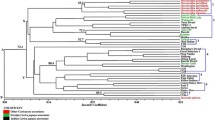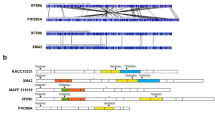Abstract
Xa27 is one of the important R-genes, effective against bacterial blight disease of rice caused by Xanthomonas oryzae pv. oryzae (Xoo). Using natural population of Oryza, we analyzed the sequence variation in the functionally important domains of Xa27 across the Oryza species. DNA sequences of Xa27 alleles from 27 rice accessions revealed higher nucleotide diversity among the reported R-genes of rice. Sequence polymorphism analysis revealed synonymous and non-synonymous mutations in addition to a number of InDels in non-coding regions of the gene. High sequence variation was observed in the promoter region including the 5′UTR with ‘π’ value 0.00916 and ‘θ w ’ = 0.01785. Comparative analysis of the identified Xa27 alleles with that of IRBB27 and IR24 indicated the operation of both positive selection (Ka/Ks > 1) and neutral selection (Ka/Ks ≈ 0). The genetic distances of alleles of the gene from Oryza nivara were nearer to IRBB27 as compared to IR24. We also found the presence of conserved and null UPT (upregulated by transcriptional activator) box in the isolated alleles. Considerable amino acid polymorphism was localized in the trans-membrane domain for which the functional significance is yet to be elucidated. However, the absence of functional UPT box in all the alleles except IRBB27 suggests the maintenance of single resistant allele throughout the natural population.




Similar content being viewed by others
Abbreviations
- BB:
-
Bacterial blight
- NBS-LRR:
-
Nucleotide binding site leucine rich repeats
- RLL:
-
Relative lesion length
- TSS:
-
Transcription start site
- UTR:
-
Untranslated region
- UPT:
-
Upregulated by transcriptional activator
- NJ:
-
Neighbor joining
References
Altschul SF, Gish W, Miller W, Myers EW, Lipman DJ (1990) Basic local alignment search tool. J Mol Biol 215:403–410
Bakker EG, Traw MB, Toomajian C, Kreitman M, Bergelson J (2008) Low levels of polymorphism in genes that control the activation of defence response in Arabidopsis thaliana. Genetics 178:2031–2043
Bergelson J, Kreitman M, Stahl EA, Tian D (2001) Evolutionary dynamics of plant R genes. Science 292:2281–2285
Bernsel A, Viklund H, Hennerdal A, Elofsson A (2009) TOPCONS: consensus prediction of membrane protein topology. Nucleic Acids Res 37 (Webserver issue):W465–W468
Bhullar NK, Street K, Mackay M, Keller NYB (2009) Unlocking wheat genetic resources for the molecular identification of previously undescribed functional alleles at the Pm3 resistance locus. Proc Natl Acad Sci USA 106:9519–9524
Bogdanove AJ, Schornack S, Lahaye T (2010) TAL effectors: finding plant genes for disease and defense. Curr Opin Plant Biol 13:394–401
Caicedo AL, Schaal BA (2004) Heterogenous evolutionary processes affect R gene diversity in natural populations of Solanum pimpinellifolium. Proc Natl Acad Sci USA 101:17444–17449
Caicedo AL, Schaal BA, Kunkel BN (1999) Diversity and molecular evolution of the RPS2 resistance gene in Arabidopsis thaliana. Proc Natl Acad Sci USA 96:302–306
Chun X, Hongqi C, Xudong Z (2012) Identification, mapping, isolation of the genes resisting to bacterial blight and breeding application in rice. Mol Plant Breed 3:121–131
Corpet F (1988) Multiple sequence alignment with hierarchical clustering. Nucl Acids Res 16:10881–10890
Cummings MP, Clegg MT (1998) Nucleotide sequence diversity at the alcohol dehydrogenase 1 locus in wild barley (Hordeum vulgare ssp. spontaneum): an evaluation of the background selection hypothesis. Proc Natl Acad Sci USA 95:5637–5642
Doyle JJ, Doyle JL (1990) Isolation of plant DNA from fresh tissue. Focus 12:13–15
Endo T, Ikeo K, Gojobori T (1996) Large-scale search for genes on which positive selection may operate. Mol Biol Evol 13:685–690
Ersoz ES, Wright MH, Gonzalez-Martınez SC, Langley CH, Neale DB (2010) Evolution of disease response genes in loblolly pine: insights from candidate genes. PLoS One 5:e14234
Feng Q, Huang T, Zhao Q, Zhu J, Lin Z, Han B (2009) Analysis of collinear regions of Oryza AA and CC genomes. J Genet Genomics 36:667–677
Fu YX, Li WH (1993) Statistical tests of neutrality of mutations. Genetics 133:693–709
Gu K, Tian D, Yang F, Wu L, Sreekala C, Wang D, Wang GL, Yin Z (2004) High-resolution genetic mapping of Xa27(t), a new bacterial blight resistance gene in rice, Oryza sativa L. Theor Appl Genet 108:800–807
Gu K, Yang B, Tian D, Wang D, Wu L, Sreekala C, Yang F, Chu Z, Wang GL, White FF, Yin Z (2005) R-gene expression induced by a type-III effector triggers disease resistance in rice. Nature 435:1122–1125
Gu K, Tian D, Qiu C, Yin Z (2009) Transcription activator-like type III effector AvrXa27 depends on OsTFIIAg5 for the activation of Xa27 transcription in rice that triggers disease resistance to Xanthomonas oryzae pv. oryzae. Mol Plant Pathol 10:829–835
Huang H, Kochert G (1994) Comparative RFLP mapping of an allotetraploid wild rice species (Oryza latifolia) and cultivated rice (O. sativa). Plant Mol Biol 25:633–648
Huang CL, Hwang SY, Chiang YC, Lin TP (2008) Molecular evolution of the Pi-ta gene resistant to rice blast in wild rice (Oryza rufipogon). Genetics 179:1527–1538
Hummel AW, Doyle EL, Bogdanove AJ (2012) Addition of transcription activator-like effector binding sites to a pathogen strain-specific rice bacterial blight resistance gene makes it effective against additional strains and against bacterial leaf streak. New Phytol 195:883–893
IRRI (2002) Standard evaluation system for rice (SES). International Rice Research Institute, Manila
Iyer-Pascuzzi AS, Sweeney MT, Sarla N, McCouch SR (2007) Use of naturally occurring alleles for crop improvement. In: Upadhyaya NM (ed) Rice functional genomics-challenges, progress and prospects. Springer, New York, pp 113–143
Kauffman HE, Reddy APK, Hsieh SPY, Merca SD (1973) An improved technique for evaluating resistance of rice varieties to Xanthomonas oryzae. Plant Dis Rep 57:537–541
Kawabe A, Innan H, Terauchi R, Miyashita NT (1997) Nucleotide polymorphism in the acidic chitinase locus (ChiA) region of the wild plant Arabidopsis thaliana. Mol Biol Evol 14:1303–1315
Koornneef M, Alonso-Blanco C, Vreugdenhil D (2004) Naturally occurring genetic variation in Arabidopsis thaliana. Annu Rev Plant Biol 55:141–172
Kover PX, Schaal BA (2002) Genetic variation for disease resistance and tolerance among Arabidopsis thaliana accessions Proc Natl Acad Sci USA 99:11270–11274
Kuang H, Woo SS, Meyers BC, Nevo E, Michelmore RW (2004) Multiple genetic processes result in heterogeneous rates of evolution within the major cluster disease resistance genes in lettuce. Plant Cell 16:2870–2894
Kumar P, Henikoff S, Ng PC (2009) Predicting the effects of coding non-synonymous variants on protein function using the SIFT algorithm. Nat Protoc 4:1073–1081
Lee S, Jia Y, Jia M, Gealy DR, Olsen KM, Caicedo AL (2011) Molecular evolution of the rice blast resistance gene Pi-ta in invasive weedy rice in the USA. PLoS One 6(10):e26260
Librado P, Rozas J (2009) DnaSP v5: a software for comprehensive analysis of DNA polymorphism data. Bioinformatics 25:1451–1452
Lin JZ, Brown AHD, Clegg MT (2001) Heterogeneous geographic patterns of nucleotide sequence diversity between two alcohol dehydrogenase genes in wild barley (Hordeum vulgare subspecies spontaneum). Proc Natl Acad Sci USA 98:531–536
Mauricio R, Stahl EA, Korves T, Tian D, Kreitman M, Bergelson J (2003) Natural selection for polymorphism in the disease resistance gene Rps2 of Arabidopsis thaliana. Genetics 163:735–746
May RM, Anderson RM (1983) Parasite-host coevolution. In: Futuyama DJ, Slatkin M (eds) Coevolution. Sinauer Associates, Sunderland, pp 186–206
Meyers BC, Shen KA, Rohani R, Gaut BS, Michelmore RW (1998) Receptor-like genes in the major resistance locus of lettuce are subject to divergent selection. Plant Cell 10:1833–1846
Nei M, Gojobori T (1986) Simple methods for estimating the numbers of synonymous and nonsynonymous nucleotide substitutions. Mol Biol Evol 3:418–426
Nei M, Li WH (1979) Mathematical model for studying genetic variation in terms of restriction endonucleases. Proc Natl Acad Sci USA 76:5269–5273
Petersen TN, Brunak S, Heijne GV, Nielsen H (2011) SignalP 4.0: discriminating signal peptides from transmembrane regions. Nat Method 8:785–786
Rajendrakumar P, Sujatha K, Rao KS, Natarajkumar P, Viraktamath BC, Balachandran SM, Biswal AK, Sundaram RM (2007) A protocol for isolation of DNA suitable for rapid seed and grain purity assessments in rice. Rice Genet Newsl 23:92–95
Reissig WH, Heinrichs EA, Litsinger JA, Moody K, Fiedler L, Mew TW, Barrion AT (1986) Illustrated guide to integrated pest management in rice in tropical Asia. International Rice Research Institute, Manila (Philippines)
Romer P, Recht S, Lahaye T (2009) A single plant resistance gene promoter engineered to recognize multiple TAL effectors from disparate pathogens. Proc Natl Acad Sci USA 106:20526–20531
Rose LE, Bittner-Eddy PD, Langley CH, Holub EB, Michelmore RW, Beynon JL (2004) The maintenance of extreme amino acid diversity at the disease resistance gene, RPP13, in Arabidopsis thaliana. Genetics 166:1517–1527
Rose LE, Michelmore RW, Langley CH (2007) Natural variation in the Pto disease resistance gene within species of wild tomato (Lycopersicon) II population genetics of Pto. Genetics 175:1307–1319
Salamov AA, Solovyer VV (2000) Ab initio gene finding in Drosophila genomic DNA. Genome Res 10:516–522
Stahl EA, Dwyer G, Mauricio R, Kreitman M, Bergelson J (1999) Dynamics of disease resistance polymorphism at the Rpm1 locus of Arabidopsis. Nature 400:667–671
Tajima F (1989) Statistical method for testing the neutral mutation hypothesis by DNA polymorphism. Genetics 123:585–595
Tamura K, Dudley J, Nei M, Kumar S (2007) MEGA4: molecular evolutionary genetics analysis (MEGA) software version 4.0. Mol Biol Evol 24:1596–1599
Tang T, Lu J, Huang JZ, He JH, McCouch SR, Shen Y (2006) Genomic variation in rice: genesis of highly polymorphic linkage blocks during domestication. PLoS Genet 2(11):e199
Thompson JD, Gibson TJ, Plewniak F, Jeanmougin F, Higgins DG (1997) The CLUSTAL_X Windows interface: flexible strategies for multiple sequence alignment aided by quality analysis tools. Nucleic Acids Res 25:4876–4882
Tiffin P, Moeller DA (2006) Molecular evolution of plant immune system genes. Trends Genet 22:662–670
Vaughan DA (1994) Wild relatives of rice: genetic resources handbook. International Rice Research Institute, Manila
Wang GL, Ruan DL, Song WY, Sideris S, Chen L, Pi LY, Zhang S, Zhang Z, Fauquet C, Gaut BS, Whalen MC, Ronald PC (1998) Xa21D encodes a receptor-like molecular with a leucine-rich repeat domain that determines race-specific recognition and is subject to adaptive evolution. Plant Cell 10:765–779
Watterson GA (1975) On the number of segregating sites in genetical models without recombination. Theoret Pop Biol 7:256–276
Yoshida K, Miyashita NT (2009) DNA polymorphism in the blast resistance gene Pita of wild rice Oryza rufipogon and its related species. Genes Genet Syst 84:121–126
Zhu Q, Zheng X, Luo J, Gaut BS, Ge S (2007) Multilocus analysis of nucleotide variation of Oryza sativa and its wild relatives: severe bottleneck during domestication of rice. Mol Biol Evol 24:875–882
Zou XH, Zhang FM, Zhang JG, Zang LL, Tang L, Wang J, Sang T, Ge S (2008) Analysis of 142 genes resolves the rapid diversification of the rice genus. Genome Biol 9:R49.1–R49.13
Acknowledgments
The authors are grateful to two anonymous reviewers for their critical review and valuable suggestions to improve the manuscript. The research is supported by Department of Science and Technology, New Delhi, India, Grant no. SR/SO/PS-21/09. The authors also thank DRR, Hyderabad, Rajendra Agricultural College, Pusa (Bihar) and NBPGR, New Delhi, for providing the germplasms. Financial supports from XI plan seed money, DBT-CREBB, DST-FIST, UGC-SAP-CAS-I and maintenance grant from University of Hyderabad is gratefully acknowledged. W.B. is also grateful to CSIR for the fellowship (Award no. 09/414/(0832)/2008-EMR-I).
Author information
Authors and Affiliations
Corresponding author
Electronic supplementary material
Below is the link to the electronic supplementary material.
425_2013_1891_MOESM1_ESM.pdf
The accessions used for isolating Xa27 alleles are indicated by asterisks (*). S† and P denote disease score and phenotype of the plant against respective Xoo strains. Scoring of disease was performed following standard evaluation system (SES, IRRI). R = Resistant and S = susceptible. (PDF 81 kb)
425_2013_1891_MOESM2_ESM.pdf
Multiple alignment of protein coding region of Xa27 alleles. Deletion of three nucleotides ‘TAC’ from eight genotypes is shown. Nucleotide changes in other genotypes is also indicated with different colors. (PDF 85 kb)
Rights and permissions
About this article
Cite this article
Bimolata, W., Kumar, A., Sundaram, R.M. et al. Analysis of nucleotide diversity among alleles of the major bacterial blight resistance gene Xa27 in cultivars of rice (Oryza sativa) and its wild relatives. Planta 238, 293–305 (2013). https://doi.org/10.1007/s00425-013-1891-3
Received:
Accepted:
Published:
Issue Date:
DOI: https://doi.org/10.1007/s00425-013-1891-3




